
Features
Crops
Flowers
Growing in the Green: If not for the weather…
January 23, 2014 By Melhem Sawaya
Poinsettia is still the largest seasonal flowering crop, though overall production has decreased by 30 per cent in recent years.
Poinsettia is still the largest seasonal flowering crop, though overall production has decreased by 30 per cent in recent years. The decrease in Canada over the past five years, however, has been more in the range of 65 per cent.
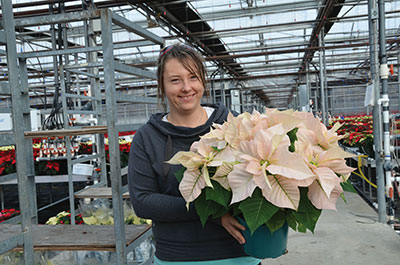 |
|
| Emma Johnston of Jeffery’s Greenhouses, with ‘Vision of Grandeur.’ Advertisement
|
The main result of the cutback was a sustainable price for growers and retailers.
The 2013 sales season was somewhat hindered by the weather. The amount of unsold product, however, was less than five per cent.
The points left over are sometimes of inferior quality.
Or these could also have been plants grown for what I call “standby” sales. Some growers wait until others sell through, and then their “standby” crop moves to stores via the original supplier. However, since the season started later than normal and the bad weather hindered catching up, these growers were stuck with some plants.
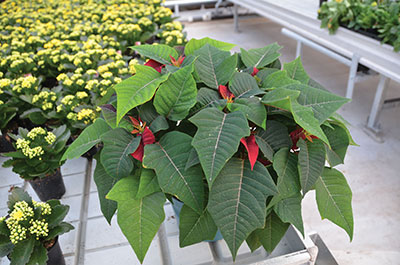 |
|
| Oops! An example of what happens with a Bonzi overdose. |
|
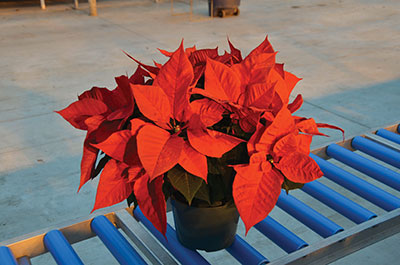 |
|
| Applying Fascination helped overcome earlier problems associated with too much Bonzi. |
My guess is that there was a five per cent increase in production in Ontario in 2013, and if the weather had been better, it would have been sold. The reality is that we’re going to deal with unfavourable weather at least once every four years or so, and any increase in production will not reach the market.
The 2013 poinsettia sales confirmed we are serving a saturated market; any increase in production will lead to sales shrinkage. And the ones hurt the most are the ones who need the most help.
It’s bad enough some product was not sold, but this will now create an environment in which buyers will want to drop prices for a product with already low margins. When supply is greater than demand, the only way buyers can boost sales is to drop prices to a point where some of their suppliers will lose money.
It is in the best interests of growers and buyers to come up with a product they can sell to retail consumers with sufficient profit margins left for everyone. If it is not a win-win situation, their relationship will eventually fail.
There are growers trying to get a share of the market by dropping prices to the point of very a narrow margin, where there is no margin for error. However, their days are numbered and their businesses will not survive. I am assuming they know their actual costs – taking all factors of their operation into consideration – but I’m doubtful.
Those growers who cost their product accurately will refuse to take an order that does not have a positive margin profit. We have to be better at marketing and that definitely does not mean dropping our selling prices below our costs.
PRODUCTION
Cuttings. The breeders’ stock producers did an outstanding job in producing excellent quality, insect-free and disease-free cuttings. As well, cuttings were shipped on time and with hardly any shipping problems; hopefully this is a trend and not an exception.
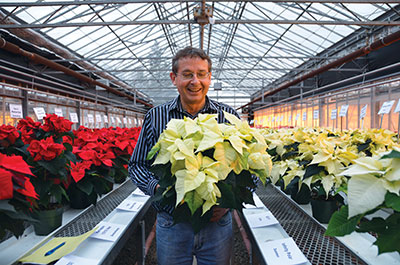 |
|
| Wayne Brown, greenhouse floriculture specialist with OMAF/MRA, coordinates the annual poinsettia trials at VRIC. |
|
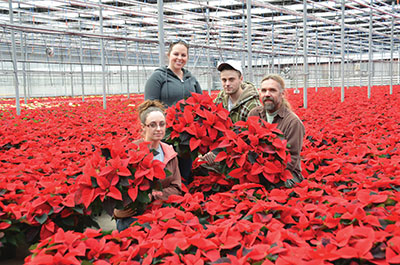 |
|
| Julie Rajnak, Shawna Hardman, Zachary Parton and Mark Healy of One Floral Group with ‘Christmas Eve.’ |
These factors combined for increased production, since growers build into their program a shrinkage percentage.
This year, shrinkage was much lower than forecast. This was largely thanks to the quality of the cuttings and the favourable rooting weather. Other factors include the technical improvements growers are implementing, more attention to detail, and most importantly, doing things on time.
Varieties. There has been a flood of new varieties on the market. Some are bad, others are OK, but most are great. In time, the best varieties will be proven and will take over most of the market.
This past season, the very best varieties all featured minimal shrinkage at selling time, during shipping and at the store level. This proves the importance of evaluating them at trial sites, such as the Vineland Research and Innovation Centre, and with in-house trials in your own greenhouse.
The same advice applies to poinsettias as it does to bedding plants. Try new varieties on a small scale to see how they work for you and how to grow them, and then decide whether to increase the trial varieties or drop them.
Take the advice of sales people, consultants and other growers only to try the new variety. You can include it in your production after you have grown it and it has proven itself on the bench and with consumers.
PROBLEMS
Pests, what pests? Whitefly was no problem this past season, whether a grower used biological treatments or chemical controls. In either case, the winners were those doing proper crop monitoring because they didn’t have to respond to many threats. The reason was that cuttings from all stock producers were very clean – no treatment of any kind by growers was needed.
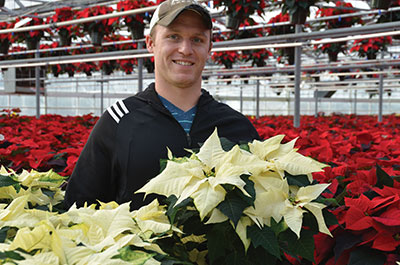 |
|
| Paul Vos of Foxwood Greenhouses enjoys some ‘Wintersun.’ Poinsettia is still the largest seasonal flowering crop with strong consumer demand.
|
|
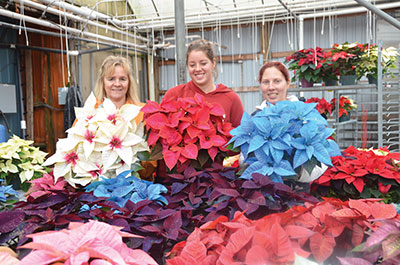 |
|
| Brenda Fluit, Tanya Heilema and Danielle Klassen of Sunshine Express with some properly painted poinsettias. |
Disease was no issue. The great weather and healthy cuttings got things off to a good start, leaving very little chance for disease.
Most growers did not use biological or chemical treatments as preventive measures. Personally, I do not believe in using a preventive biological or chemical treatment; what is better is to use the proper cultural system. Preventive treatments are false security if you do not follow proper cultural practices, and if you follow proper cultural practices, you do not need any preventive treatments!
Managing the environment. Physical disorders are few, but if a light is accidentally left on overnight, it will often not be noticed until a section of plants remains green a little longer than the rest of the crop due to night interruption. Similarly, high night temperatures will have the same effect in delaying flowering, and this can be caused by a heat valve that is stuck open; unfortunately, the problem is not noticed until later in the growing season!
TRIALS
Many breeders are getting the message and they are trying potential introductions in a commercial grower setting in addition to relying on institutional trial sites. This ensures a more realistic assessment of the introductions and gives growers a chance to see how best to handle these varieties if they are introduced.
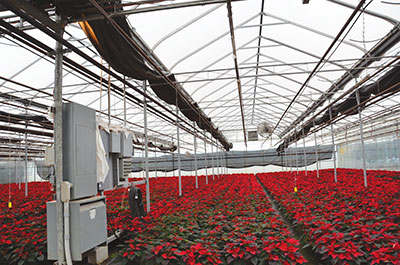 |
|
| What can happen if a light is accidentally left on overnight.
|
|
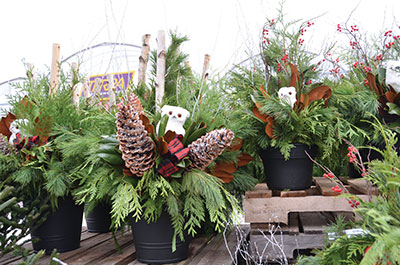 |
|
| Want to increase yuletide sales? Add more greenery products. Many consumers can’t get enough of them. |
I noticed in the 2013 trials there were more numbered varieties than ever before. This is a good thing, as long as we’re adding improved varieties while dropping some of the ones that are not performing well.
As you will see from the pictures, growers have different preferences and all have their reasons for them, ranging from simply performance-based selections to varieties recommended by others. Hopefully, it is primarily a performance-based decision at the end of the day!
I’ve also included some photos to show some disorders, along with others to show potentially good varieties.
SUMMARY
- Grow varieties that you are familiar with, and try new ones on a small scale.
- Calculate all the costs for any required specs.
- Take an order when there is still some margin profit and not just base it on dollar sales.
- Never grow purely on speculation.
- If you run out at the end of the season and you have to buy plants to fill your orders, that is when you are starting to make some profit on any crop.
- Do not cheat on growing your crop. Give it what it needs and do it on time.
- Be creative and try to sell a new appealing product that you and your customer can make a profit on.
- Do not get into the trap of price reduction so you can sell your product. Come up with an alternative!
Melhem Sawaya of Focus Greenhouse Management is a consultant and research coordinator to the horticultural industry. Comments on this or any other article are welcome at mel@focusgreenhousemanagement.com, or by visiting www.focusgreenhousemanagement.com .
Print this page